Are you confused by RV weight and what your vehicle can safely tow? Here is a camper towing guide to help you.
Don’t fret; you are not alone. With so many things you need to consider to achieve safe camper towing it can seem overwhelming.
I compiled this comprehensive camper towing guide on trailer and tongue weights, towing capacity of your vehicle, hitches, safety rules, tips, and more so you can get out on the road and start camping!
The Magic Numbers
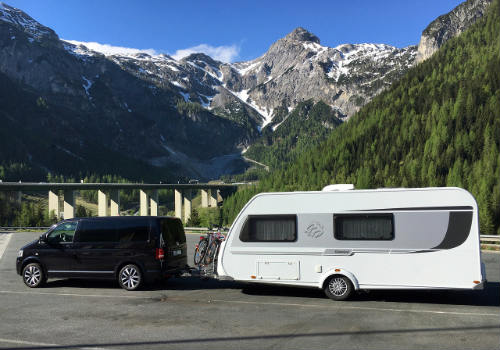
In order to achieve a safe combination of tow vehicle and camper you will need to know these numbers:
- Tow vehicle Gross Vehicle Weight Rating
- Camper dry weight
- Tongue weight
Along with these numbers you will also need information on:
- Weight of supplies
- Proper weight distribution
- Tow vehicle safety features
- Camper safety features
- General towing safety rules
With experience, you’ll quickly understand the need for all these considerations when towing your RV. It will become part of your camping routine, just like picking out your next camping destination.
Once you become an RV enthusiast, it becomes common every few years to upgrade or change your camper. Many people transition to a fifth-wheel camper and need to install a large hitch into the bed of their pickup if they already own a truck capable of towing such a large camper.
Having a solid knowledge of vehicle weight ratings and tow capacities will make these transitions easier. Especially if you do not want to upgrade your tow vehicle.
Truck Ratings for Camper Towing
Trucks are the most popular vehicle for towing a camper. Everyone has heard of 1/2 ton, 3/4 ton, and 1-ton trucks and think these numbers symbolize the weight capability that each truck can haul safely.
Trucks initially were rated in this way, but this is not true nowadays. For example, a 1-ton 2015 Dodge Ram 3500 has a GVWR of 7,390 pounds, which is well over three tons.
There are models of 1/2 ton trucks that range in GVWR from 1,000 to 3,000 pounds. This range in numbers is a perfect example of why you need to find the specific gross vehicle weight rating for your tow vehicle and not just assume it by the “ton” rating of a truck.
Let’s get started on the various camper towing guide topics so you can gain a full understanding of what towing a camper safely entails.
The Facts on Camper Towing Capacity
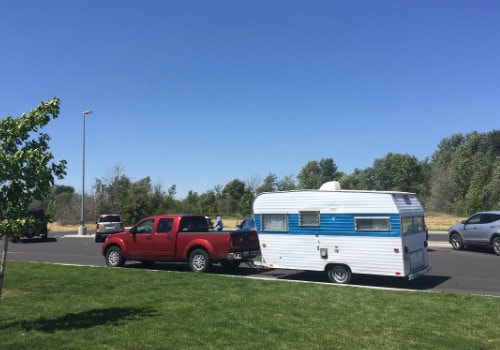
What is towing capacity and where can you find a vehicle’s tow capacity figure?
You can find the tow rating number in your owner’s manual, glove compartment, or truck door post. You can also find it through an online guide by make and model or your truck by VIN number.
Once you’ve found your vehicle’s tow capacity rating, knowing this number and what it means for choosing a camper can still be complicated.
Your vehicle may have had a heavy-duty tow package as an add-on, or your car has a hitch but it’s not rated for camper towing.
If a vehicle is tow-capable and you can install a tow hitch, there will be a safe weight of camper you can tow behind it without causing damage to the engine, transmission, cooling system, axles, brakes, and frame.
Because hitches can fit many different types of tow vehicles, the hitch rating may exceed the capability of the tow vehicle you own or intend to use to pull your camper. Always follow the truck or car manufacturer’s designated towing capacity to prevent damage to your vehicle and camper.
You can determine the safest maximum towing capacity by using the lowest-rated element in the chain of these hitch components:
- Trailer rating
- Ball hitch rating
- Tongue rating
- Tow vehicle rating
Any weak link in this chain can lead to disaster when traveling at highway speeds with a full camper. If you exceed these rating numbers and an accident occurs, your insurance may not cover the damage, or you could be breaking towing laws.
Hitch Rating
First of all, there are many different types of hitches on the market. There are hitches specific for fifth-wheel campers that attach in the bed of a pickup truck. Other towable campers can use these types of hitches:
Bumper hitches
Bumper hitches connect to an SUV or truck bumper and have a square-shaped receiver tube that will work with an array of hitch setups. Bumper hitches are best for lightweight towing of small camper trailers.
Weight distribution hitches
A weight distribution hitch is ideal if you own a pickup truck. These hitches make tongue weight less of an issue because they have spring rods that keep the hitch weight in balance.
Pintle hitch
Pintle hitches are not very common, but they can pull trailers up to 60,000 pounds. These look like a claw and are known to be noisy.
Gooseneck hitch
A gooseneck hitch is similar to a fifth-wheel hitch, except it connects to a ball hitch. A gooseneck attaches to the rear axle of your pickup truck, opening up the bed of the truck to give you room for carrying camping gear.
Rear receiver hitch
Rear receiver hitches are the most frequent hitches people use for towing. These hitches connect to the vehicle’s rear and have a square receiver, similar to a bumper hitch. There are five weight classes available with a rear receiver hitch, making it simple to buy one that matches up with the rating of your vehicle.
Your hitch will have its own rating for allowable stress on the metal fabrication. Many campers have a comprehensive hitch system. In other cases, you will have to purchase a separate hitch, which may come in several parts.
If you’re buying a used camper or tow vehicle that has a hitch system installed, you’ll need to check the rating of each component to be sure it’s safe for your application.
Your hitch should have a label that states the hitch’s maximum tow weight rating. If you cannot find this label, buy a new hitch that suits your tow vehicle’s ratings.
It’s not wise to trust a seller’s statement on the strength capabilities of a hitch that is not labeled.
Ball/Mount Hitch Rating
You can find the hitch ball rating stamped into the top of the ball, or around the base of the shank. The ball mount rating is usually on a label on the mounting plate or along the shaft that goes into your receiver.
The Facts on Gross Vehicle Weight Ratings
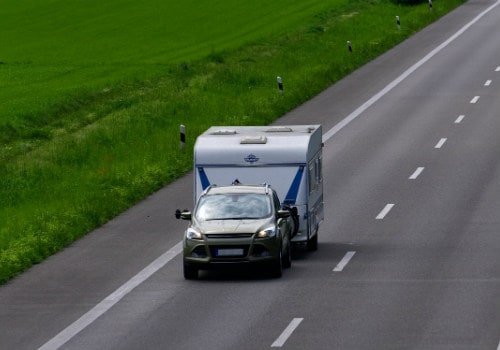
A vehicle’s gross weight rating (GVWR) is how many pounds it can safely weigh when fully equipped and loaded with cargo and passengers. This number does not include any trailer you may wish to tow.
The GVWR of a vehicle never changes. This number is not the gross vehicle weight (GVW )of a loaded truck, but the weight limitation your vehicle can safely handle.
For example, your vehicle’s GVR weight is 5,500 pounds and has a GVWR of 8,000 pounds. That means you can add 2,500 pounds of passengers and cargo safely with no damage to your engine or axles if you distribute that additional weight evenly.
If you load all of your cargo behind the rear axle of the vehicle, it will raise the front end of the vehicle enough to make it challenging to steer since the tires will not have enough grip on the road surface.
By not distributing cargo weight evenly you’ll risk damage to your axles, springs, and possibly even the vehicle framing.
When towing a camper, the final tow-capacity number must include the weight of a camper full of supplies plus the weight of passengers and cargo that you’ll carry in the tow vehicle.
Trucks will have a payload rating that limits the amount of cargo you can put in the bed of the truck before it creates a dangerous situation on the rear tires from sagging.
You never want to exceed the GVWR for your tow vehicle. If you need to have more tow capability, you’ll have to upgrade to a larger vehicle with a higher rating.
The Facts on Trailer Weight
There is a “dry weight” given to a camper trailer or motorhome, which is the number of pounds the camper or RV weighs after manufacture.
The dry weight is the number given to the empty camper before you fill it with supplies. You can’t choose a camper that has a dry weight of 5,000 pounds if you have a vehicle that has a 5,000-pound tow capacity.
You must always take into consideration the additional weight of camping gear you will put inside your camper or motorhome like:
- Water
- Food
- Bikes
- Grill
- Tools
- Propane
- Clothes
Not taking into account this added weight is a common mistake made by first-time campers. Depending on camper size, you can easily add 500-1,000 pounds of supplies, if not more.
You can avoid damage and accidents due to overweight trailers by leaving plenty of wiggle room for additional weight when buying your camper.
Is there a place you can weigh a camper?
Most RV retailers will have scales that you can use to weigh the trailer and cargo that you plan to tow. If you can’t locate an RV dealer with scales, you can opt for paying to use scales at a truck stop.
Take a trip to the scales with your unloaded tow vehicle and camper, and again with your loaded camper. Note the weight difference and verify you’re within safe GVWR numbers.
You’ll learn if you are overpacking supplies and therefore overtaxing your tow vehicle or camper and can adjust your load accordingly. You’ll be happy if you come in underweight, which is safer and will save on gas mileage.
Tongue Weight vs. Hitch Weight
If you don’t have enough to consider when choosing a camper, there is still another number, the tongue weight, that you need to know and understand to tow your camper safely with your vehicle.
There is technically no difference in tongue and hitch weight. Some refer to travel trailers as having a tongue weight and fifth-wheel trailers as having a hitch weight, but both refer to the same thing.
Tongue/Hitch Weight
Tongue or hitch weight is the downward force that the tongue of the trailer will apply to the hitch of the tow vehicle. Experts agree that an acceptable weight at this point of the hitch for any trailer is between 9 and 15% of the gross trailer weight.
Why is this important?
If the tongue weight of the trailer is too light, it will not exert enough downward force on the hitch ball attached to the tow vehicle. This lack of downforce can result in a dangerous condition known as trailer sway.
If the tongue weight is too heavy, you will have difficulty steering the tow vehicle, which again is a dangerous situation.
Luckily, you can take a few simple steps to adjust tongue weight to make camper towing safe.
The axle of the camper trailer acts as a fulcrum or pivot point for the weight of your camper’s cargo. If your tongue weight is too light, move some cargo forward of the axle.
Do the opposite if your tongue weight is too heavy; adjust cargo to the rear of the axle. By creating a proper balance in the trailer, you will achieve a safe tongue weight for towing.
How to Determine a 9-15% Tongue Weight
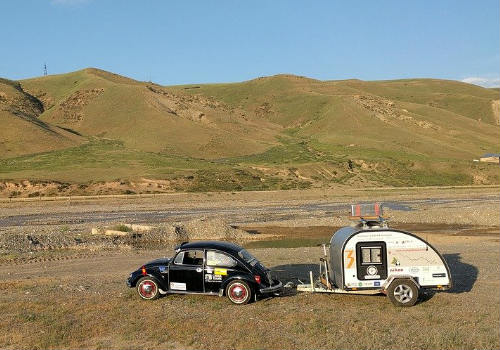
Knowing your gross trailer weight is crucial to set the right tongue weight of your trailer. If you have the gross trailer weight (dry weight) of your trailer from the manufacturer, you can do the math to reach the number you want to show for your tongue weight.
You can bring your camper to a set of commercial scales, like those found at truck stops to get an accurate weight if you do not know your gross trailer weight.
If, for example, your math shows you need a tongue weight of 82 pounds. This number is well within the range of a standard bathroom scale, so buy one or grab it from your bathroom and bring it outside to use it to get a tongue weight.
Prop the scale onto blocks, so it’s at the same height as your tow hitch. Carefully lower the tongue of your camper trailer onto the scale in such a way that you can see the readout.
If the number is not within the safe range of 9 to 15%, go inside your camper and adjust your cargo forward or back. Check the tongue weight again and keep making adjustments with the interior cargo until it is correct.
Once you have the right tongue weight, take a good look at how you have your cargo arranged so you can get ready to leave on your next camping trip quicker.
If you have a large camper that will exceed your bathroom scale’s weight restrictions, you can purchase a commercial scale made for this purpose.
With experience, you will get a feel for your tongue weight just by the way it handles while pulling your camper and also by visual cues.
If you see the camper tipped oddly forward or backward while on the hitch, it is a sure bet the cargo load is out of balance, and your tongue weight will be off.
Weight Distribution
Proper weight distribution inside your camper and tow vehicle is another topic that you should not overlook.
Just because there is space available inside your camper and vehicle does not mean you can cram it full with supplies and cargo and expect to reach your camping destination with no issues. This is a rookie mistake.
Even if you do make it to your camping spot in one piece, you have put into motion wear and tear that will continue to erode your vehicle’s components until failure does occur.
All campers will have Gross Axle Weight Ratings (GAWR), which are measurements of specific wheel position loads at the axle. By knowing how much load you are putting on the axles you can set the appropriate tire pressure to handle the load.
There are some people who go the extra mile to weigh each axle of their camper while it’s fully loaded to make sure it’s within the safe rating numbers.
As a general rule, you can skip this step and just be conscientious about balancing your cargo load’s weight evenly front to back and side to side in the camper.
For example, many trailer campers have one area with plenty of cabinets, and across from it can be a refrigerator or stove. When you fill the cabinets with food and supplies, the weight of the appliances across from them will help balance out the load.
When loading your camper you should:
- Keep cargo secure
- Keep center of gravity low
- Prevent shifting of furniture
- Equalize weight between front and back
- Equalize weight between right and left sides
Loss of control of both your tow vehicle and camper can occur if you do not distribute weight as set by the RVs specifications.
Overloaded axles snap more often than you think. Imagine that happening while doing 65 mph on the highway.
You must always take preventative steps to keep you, your family, your tow vehicle, camper, and others on the roads safe.
Reasons to Consider a Diesel Engine
Diesel engines offer high torque numbers, which give them the ability to pull a camper with little wear and tear on the engine. Diesel engines give off most of their power in the low gears, making starts and stops easy.
Because of this difference in the way a diesel engine pulls, it has become a favorite among serious campers who make a lot of cross-country trips or travel mountainous roads.
If you do go diesel, be aware that engine repair can be more costly and you will have to be on top of changing the fluids more often than in a gasoline engine to keep things running smoothly.
Can You Increase a Truck’s Towing Capacity?
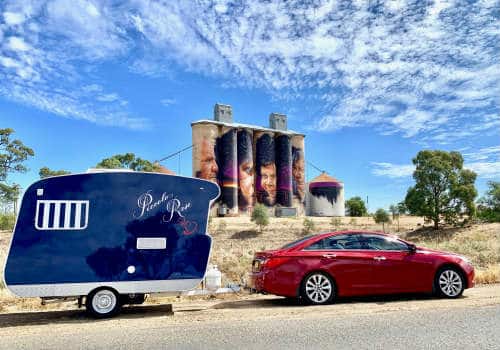
If you find a camper that is perfect for you, but your truck is right on the edge of being able to tow it, there can be a solution other than buying a more massive truck.
As long as the desired payload doesn’t exceed the GVWR, a gooseneck or fifth wheel hitch can improve your hitch load limit by altering weight distribution for safer towing.
Other Vehicle Towing Safety Equipment
So you have your figures on tow capacity, payload rating, tongue weight, gross vehicle rating weight, and camper dry weight.
There are still a few other things you can do to make sure your vehicle can safely tow your camper. Many of these elements have their own ratings for weight or stress, so if they do make sure they fit within the parameters of your tow vehicle and camper numbers.
Read on for more information about towing safety equipment.
Trailer Signal Wiring
You have a tow hitch on the back of your car, SUV, or truck and you need electrical plugs there so you can attach your trailer lights assembly. These lights will signal to drivers behind you when you are braking or turning, just as your tow vehicle is doing.
Always check that these lights are working correctly before you tow your camper. Do a walk-around while another person is working the brakes and signals to verify they light up brightly and function as they should.
Anti-Sway Control
You can have a stability control system installed that uses sensors to detect if your camper is moving side to side too much and automatically applies the brakes to one wheel which will bring the camper back into line.
This safety feature also presents itself in anti-sway bars installed to brace the axle of the vehicle to the chassis to distribute weight more evenly.
You can read more on anti-sway bars for RVs and camper trailers here.
If a gust of wind or a strong draft from a passing truck makes your trailer starts to sway, you need to act decisively to get the sway under control as quickly as possible.
Follow these steps to remedy the sway:
- Gradually reduce speed
- Hold steering wheel steady
- Only apply trailer brakes
- Never slam on your tow vehicle brakes which will cause jacknifing
- Do not attempt to steer out of the sway, it will make it worse
If swaying continues, stop towing the trailer until you can find what is causing the problem and get it fixed.
Integrated Trailer Brake Control
A quality camper trailer will have an integrated trailer brake control system put in during manufacture. This system will simultaneously apply brake pressure to your trailer wheels along with the brakes on your tow vehicle.
An integrated trailer brake system enables you to maintain more stability and control of both your tow vehicle and camper, which is safer for everyone on the road.
Many states have requirements for a separate braking system on towed trailers with loads more than 1,500 pounds. Do your due diligence, so you are not breaking any laws while traveling, especially if you will pass through several different states.
Hill Descent Control
Similar to trailer brake control, the hill descent control system uses specials gears and brakes to keep your tow vehicle and camper at a safe speed on downhill slopes. This feature is even more beneficial when driving hills in rain.
Oil/Transmission Cooler System
Consistently towing a heavy camper will strain your tow vehicle’s engine and transmission. It can be a wise investment to install an oil and transmission cooler system.
Automakers have packages for oil and transmission cooling systems that can help increase towing capacity.
When an engine is under constant stress while towing a camper, the temperature of fluids will rise. By keeping these fluids cooler, your engine will run more reliably and last longer.
Weight Distribution System

A weight distribution system is generally recommended for trailers over 5,000 lbs. when fully loaded. This will help prevent swerving and swaying of your camper while in tow.
Towing With a Car
Towing a camper with a car is possible if your camper is light and your vehicle has appropriate towing power. Many larger sedans, crossovers, and SUVs have serious tow capacity.
You must use all the same principles for car towing as with towing with an SUV or truck, by not exceeding the GVWR and tow capacity numbers, and by using a safe hitch system.
Double Towing
It is very common for RVers to tow another small vehicle or trailer behind their camper.
Known as double towing, this practice has to still fall within the parameters of your tow vehicle’s ratings, as well as additional safety equipment to make sure everything will tow smoothly.
If you even remotely think you may wish to do this, make sure you have an appropriate vehicle that can handle the extra tow load.
State Towing Laws
Every state has their own laws on towing. When you choose to pull a camper, it is your responsibility to know and obey state rules for towing.
Some states allow double and even triple towing, others may have weight restrictions on certain roads.
This reference guide from Brake Buddy will give you the towing laws for each state.
Remember that double towing will increase how long it takes to accelerate and come to a full stop. You will need to allow more time and space when changing lanes and passing other vehicles.
In order to be as safe when towing or double towing, you need to have unobstructed visibility. You may need to add extended length side-view mirrors to see all the way to the rear of your camper and to see traffic approaching from the sides of your trailer.
Rear-vision cameras are becoming popular with newer model campers, with a monitor that you can mount near the driver’s seat. If your camper does not come with a rear camera, you can purchase an easy-to-install wireless set from many camping stores or online.
Being able to see the rear of your camper makes backing up and parking more comfortable, and can warn you if someone is following too closely while on the road.
Safe Towing Tips
Knowing what camper and weight your vehicle can safely tow are not all you need to be aware of when you set out on your camping adventure. There are still a few more points that need to be brought up to complete this guide.
First, never travel with passengers or pets in your tow camper. With no seat belts or air bags, a sudden stop will hurtle any pets or passengers into camper walls with violent force.
This next point is for those taking out a camper and tow vehicle combination for the first time. After 50 miles stop and check the hitch, the way the camper sits, the tires, and all lights and wiring connections to make sure it all still looks good.
The final tip should become part of your regular camping routine. On any trip, when you stop either for gas or just for a rest, check on your towing set-up. Do a complete walk around, looking closely at your camper and tow vehicle from top to bottom.
Spotting an issue during this five minute check can prevent it from becoming a severe problem or a downright disaster in the future and is an essential part of safely towing a camper.
Conclusion
When you tow your camper, it’s nice to have peace of mind that you are doing all you can to keep your passengers and others on the road as safe as possible. Watch this video to see camper towing mistakes in action.
After watching, you will see just how quick and devastating a camper accident can be, and why you want to take every precaution available to prevent such mishaps.
Camping trips should be about making memories and enjoying the outdoors, not sitting on the side of the road waiting for help when your camper towing system fails.
I hope this camper towing guide gives you the tools you need to know what your vehicle can safely tow. It’s a lot of information, but once you pinpoint the details for your particular towing set-up, the rest of the steps are simple to follow.
Do you have any tips to share from your own experience towing a camper? Tell us about it!




